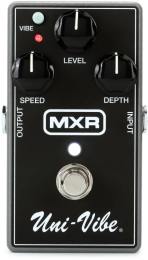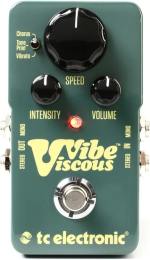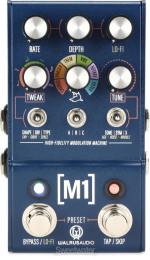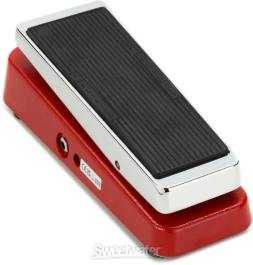The Uni-Vibe has long been the secret weapon of guitar players aiming to produce a timeless vibe that’s both ethereal and grounded, swirling yet direct. With its unmistakable modulation effect, the Uni-Vibe adds a mesmerizing coloration to your guitar tone, echoing the nuances of a rotating speaker.
Originally designed in the 1960s by audio engineer Fumio Mieda for the Japanese producer Shin-Ei, the Uni-Vibe was intended to emulate the Doppler sound of a rotating Leslie speaker used with an organ.
However, the pedal ended up bringing to life a unique modulation effect of its own that captured the imagination of eclectic guitarists in the late 60s. The characteristic "throbbing" effect it produces has been immortalized in some of the most iconic rock and psychedelic tracks of all time.
In this article, we’ll dive into the best Uni-Vibe pedals available today and explore the different features and capabilities that make them stand out. Our pick for the best overall Uni-Vibe pedal is the JHS Unicorn V2 Analog Uni-Vibe Pedal for its authentic sound and versatility.
Honorable mention goes to the Walrus Audio Mako Series M1 for its endless customization options, which make it an invaluable companion both in the recording studio and onstage.
Keep reading to find out more about the best uni-vibe pedals on the market today!
Quick Summary of the Best Uni-Vibe Pedals
- JHS Unicorn V2 Analog Uni-Vibe Pedal (Best Overall)
- MXR M68 (Best Vintage Vibe)
- NUX Voodoo Vibe Mini Uni-vibe Pedal (Best Under $100)
- TC Electronic Viscous Vibe (Best Digital Uni-Vibe Pedal)
- Earthquaker Devices The Depths v2 (Best Analog Univibe Pedal)
- Walrus Audio Mako Series M1 (Best High-End Uni-Vibe)
- Dunlop Rotovibe (Best Expression Pedal)
Best Uni-Vibe Pedals
1. Best Overall – JHS Unicorn V2 Analog Uni-Vibe Pedal

SPECS
- Analog/Digital: Analog
- Control Parameters: Speed, Volume, 4-position speed ratio, mini toggle switch
- Footswitch Option: On/Off footswitch for effect bypass, separate tap tempo footswitch input, expression pedal input, tap input/output.
The JHS Unicorn V2 Analog Uni-Vibe pedal skillfully merges vintage tonality with modern functionality, providing the best of both worlds. This fully analog unit uses a vintage-style photocell modulator to deliver rich, swirling sounds reminiscent of classic Uni-Vibe effects.
The pedal comes with an extremely handy tap tempo control, allowing you to dial in precise speeds in 1/4 note, 1/8 note, dotted 1/8 note, and triplet rhythms.
It also offers up to 9dB of volume boost and a mini toggle switch for wet/dry mixes, while its true bypass switching ensures your tone remains pristine when the pedal is not in use.
The JHS Unicorn V2 Analog Uni-Vibe offers a unique, retro vibe and great value for money, so if you're looking to recreate the sound of guitar legends of old, this pedal should definitely be on your board.
Plus, make sure to check out the JHS's YouTube channel, an invaluable source of information for guitarists sculpting their sound through pedals.
2. Best Vintage Vibe – MXR M68

SPECS
- Analog/Digital: Analog
- Control Parameters: Rate, Depth, Vibe Button (switches between chorus and vibe mode)
- Footswitch Option: On/Off footswitch with true bypass
This MXR Uni-Vibe Chorus/Vibrato pedal is a faithful reissue of the classic Uni-Vibe effect, bringing its unmistakable, warm, undulating tones into the modern era.
This pedalboard-friendly unit comes with a streamlined three-knob interface for rate and depth and a Vibe button to toggle between chorus and vibe modes.
Whether you're looking for subtle shimmers or intense, mind-bending throbs, the MXR Uni-Vibe's range of effects has you covered: plug it into a tube amp on the edge of breakup, and you're ready for sonic exploration.
Plus, we really appreciated the pedal’s true bypass switching, which ensures the guitar tone remains uncolored when the pedal is deactivated.
Ideal for tone purists and those looking for authentic, vintage-inspired modulation, the MXR M68 is a compact and budget-friendly yet excellent option.
3. Best Under $100 – NUX Voodoo Vibe Mini Uni-vibe Pedal

SPECS
- Analog/Digital: Digital with analog emulation through DSP
- Control Parameters: Intensity, Speed, Mode switch (Vibe and Chorus)
- Footswitch Option: On/Off footswitch
Inspired by the classic Dunlop Uni-Vibe, the NUX Voodoo Vibe Mini is a tiny pedal offering two modes: Vibe and Chorus.
It comes with modern DSP technology to create a blend of analog warmth and digital precision, which allows features like Smart Tap Tempo and improved Chorus mode without volume drop issues.
In Chorus mode, the Intensity knob adjusts the depth of the effect, while in Vibe mode, it modulates the tone. The Speed knob allows you to tailor the rate of the effect, from slow sweeps to quick pulses.
Unlike the original Uni-Vibe, which required 18V, this updated version operates on a more convenient 9V power supply. All in all, the Voodoo's small footprint, affordability, and customization options make it a great choice for those looking to capture vintage vibes with modern reliability.
4. Best Digital Uni-Vibe Pedal – TC Electronic Viscous Vibe

SPECS
- Analog/Digital: Digital with analog fidelity through Analog-Dry-Through
- Control Parameters: Speed, Intensity, Mode switch (Vibe Chorus and Vibrato)
- Footswitch Option: On/Off footswitch
The TC Electronic Viscous Vibe captures the unique modulation styles of the original Shin-Ei Uni-Vibe but with plenty of modern enhancements.
Built around a powerful Freescale DSP engine, the Viscous Vibe offers emulations of both the "vibe" chorus and the straight-up vibrato effects found in the original Uni-Vibe. You can make precise adjustments to these effects via the Speed and Intensity knobs.
The pedal also allows for speed-ramp-up effects, a feature available by holding down the footswitch. What impressed me the most was the pedal's TonePrint technology, which gives the possibility to adjust the pedal’s modulation effects as well as access custom artist presets.
Finally, it offers both stereo I/O and the choice between buffered or true bypass, giving you ultimate flexibility in signal routing.
Despite being a digital pedal, the Viscous Vibe's Analog-Dry-Through feature ensures your original tone remains untouched, bringing to life an authentic and articulate sound that you'll never get bored of.
5. Best Analog Univibe Pedal – Earthquaker Devices The Depths v2

SPECS
- Analog/Digital: 100% Analog
- Control Parameters: Intensity, Level, Rate, Throb, Voice
- Footswitch Option: Flexi switch
The EarthQuaker Devices The Depths V2 is an optical vibe effects pedal with a distinctive sound signature inspired by iconic psychedelic rock guitar tones. The second-generation model incorporates a Flexi switch that allows for either momentary or latching operation, offering more control and versatility.
You'll be impressed by The Depths v2's range of control parameters. Alongside the traditional Intensity, Level, and Rate controls, you'll find Throb and Voice knobs that allow for extensive sound shaping.
The Throb control adds a low-end pulse to your tone, while the Voice knob adjusts the overall performance of the pedal: turn it up for a fuller, more bass-rich sound or dial it back for a thinner, mid-focused tone.
Being an analog pedal, The Depths v2 ensures a pure and organic sound signal path, and it comes with a true bypass to preserve your original tone. You can also run the pedal at 18V for higher headroom and more dynamics.
With a more modern and versatile sound palette than most Uni-Vibes included in this list, the Earthquaker Devices The Depths v2 will no doubt be an excellent addition to your pedalboard.
6. Best High-End Uni-Vibe – Walrus Audio Mako Series M1

SPECS
- Analog/Digital: Digital
- Control Parameters: Tweak, Tune, Dedicated "Lo-Fi" knob, 3-way switch for Shape, Division, and Type, Dedicated "X" setting
- Footswitch Option: Tap/Skip footswitch, bank switch for presets, plus MIDI Capabilities (up to 128 presets)
The Walrus Audio Mako Series M1 is a high-fidelity modulation pedal designed to offer an extensive range of modulation effects, making it an incredibly versatile addition to any pedalboard.
From classic '80s chorus sounds to rotary speaker effects and beyond, the M1 is engineered for guitarists looking to sculpt unique and unconventional tones.
The M1 comes with six modulation programs (Chorus, Phaser, Tremolo, Vibrato, Rotary, and Filter), each with three distinct types that lend themselves to a wide array of sound-crafting opportunities.
One of the standout features is the pedal's "X" setting, accessed via the Tune knob, which varies depending on the selected effect and offers further creative control.
For example, it adjusts the maximum level of pitch detuning in Chorus and adds feedback in Phaser, enhancing the dramatism of the tone.
The "Lo-Fi" knob is another unique control parameter that interacts with the Tweak and Tune settings, offering additional textural options compared to other uni vibe pedals.
The M1 also offers powerful preset management, featuring nine onboard preset slots that are readily accessible via the bank switch. Additionally, up to 128 presets can be stored and accessed through MIDI, making it a phenomenal companion for professional live performance setups.
The LED changes colors to indicate which preset is selected and whether it's been edited, allowing on-the-fly adjustments during a performance.
The Walrus Audio Mako Series M1 also comes with a Tap/Skip footswitch that mimics the sound of a needle skipping on a record, adding yet another layer of creativity for those looking to push sonic boundaries.
All in all, this is one of those rare pedals that can single-handedly upgrade a guitarist’s sound signature, and musicians shaping their own distinct soundscapes should definitely give the M1 a try.
7. Best Expression Pedal – Dunlop Rotovibe

SPECS
- Analog/Digital: Analog
- Control Parameters: Foot pedal control for modulation speed, side-mounted knob for modulation depth, Vibrato and Chorus modes
- Footswitch Option: on/off switch
Looking a lot like Dunlop's iconic Crybaby wah, the Rotovibe pedal delivers that classic rotating speaker sound, offering both vibrato and chorus modes for tonal flexibility.
What makes the Rotovibe attractive is its expression pedal, which allows you to control the modulation speed in real-time. This is especially useful for musicians who want to change the rate of modulation on the go, perhaps in the middle of a solo or a specific section of a song.
LED speed indicators are a great addition, so you can check at a glance where your modulation speed is set.
The pedal also features a redesigned quiet switching system, which ensures that you can switch the pedal on or off without any of the unwanted noise or pops that can sometimes accompany stompbox use.
Finally, a side-mounted knob lets you customize the modulation depth, recreating anything from subtle movement to intense, swirling sounds.
The Dunlop Rotovibe is a versatile modulation pedal that combines a unique design with tonal diversity, providing that classic rotary speaker vibe with the added benefits of modern functionality.
Best Uni-Vibe Pedals Buyer's Guide
Now that you know most of the best Uni-Vibe pedals in the market, it’s time to figure out how we identify the best pedal based on our budget and needs. Below you’ll find the most crucial aspects to consider when buying a new Uni-Vibe pedal.
Analog vs. Digital
The debate between analog and digital Uni-Vibe pedals is often a matter of personal preference. Many guitarists believe that analog pedals come closer to capturing the "magic" of classic Uni-Vibe tones.
On the other hand, digital models have made significant advancements in emulating the subtleties of analog sound; plus, they tend to be less expensive, more versatile, and often include extra features like presets or additional waveforms.
If you love vintage tones, analog may be the way to go, but if you value versatility and a smaller price tag, digital units are your best bet.
Footswitch Options
Footswitch options on Uni-Vibe pedals can significantly impact their usability, particularly in live settings. Basic pedals may come with a single footswitch for toggling the effect on and off.
More advanced models include additional footswitches for speed settings, intensity, or even to switch between vibrato and chorus modes.
Most pedals these days offer an external footswitch jack, allowing you to connect an auxiliary footswitch or expression pedal for hands-free control over parameters like speed or intensity.
Control Parameters
The basic controls found on most Uni-Vibe pedals are speed, intensity (or depth), and volume. The "Speed" knob controls the rate at which the effect oscillates, while the "Intensity" or "Depth" knob regulates how pronounced the modulation is. Volume control... well, you can guess.
Modern and more sophisticated models offer additional controls, like waveform shape selectors, that allow for a wider variety of sonic textures.
Advanced units may also feature a tap tempo feature for synchronizing the modulation rate to the music or even tone knobs for fine-tuning the frequency response.
Price
Uni-Vibe pedals vary significantly in price based on features, build quality, and brand reputation. Budget options under $100, like the NUX Voodoo Vibe, are usually digital and offer basic controls but may lack the nuanced tone of more expensive models.
Mid-range models priced between $100 and $300 provide a broader spectrum of choices, including both analog and digital circuits, more control parameters, and better build quality.
High-end models exceeding $300, like the Walrus Audio Mako Series M1, often feature boutique-level craftsmanship, premium components, and extensive controls for fine-tuning your sound.
Frequently Asked Questions (FAQs)
How does a Uni-Vibe pedal work?
A Uni-Vibe replicates the sound of a rotating Leslie speaker using a specific form of phase modulation. The pedal uses a series of light-dependent resistors and a pulsating light source to create a sweeping, undulating effect that varies in speed and intensity based on user settings.
The result is the rich, psychedelic tone that defined the sonic signature of iconic guitarists such as Jimi Hendrix and David Gilmour.
What are the essential controls on a Uni-Vibe pedal?
Essential controls on a Uni-Vibe pedal generally include "Speed," which dictates how fast the effect oscillates, and "Intensity," or "Depth," controlling how pronounced the modulation is.
Some models also offer a volume knob to adjust the output level and may feature additional settings for waveform shape or modulation style.
How do I set up a Uni-Vibe pedal in my signal chain?
A Uni-Vibe pedal is generally placed after overdrive or distortion pedals but before delay and reverb effects in the signal chain.
This placement allows the Uni-Vibe to modulate a cleaner signal, ensuring that its unique tonal qualities are more transparent and pronounced while not conflicting with spatial effects like reverb.
Which artists are known for using Uni-Vibe pedals?
Artists such as Jimi Hendrix, David Gilmour, and Robin Trower have famously used Uni-Vibe pedals to create their iconic tones. The pedal is most closely associated with the psychedelic and classic rock genres but has been adopted by musicians across various styles to add texture and depth to their sound.
Hendrix's ethereal "Machine Gun" and Gilmour's mesmerizing solos in Pink Floyd's "Breathe" are perhaps the most famous examples of the pedal’s range and sonic capabilities.
However, the Uni-Vibe is still incredibly popular today, especially among guitar players looking to add a vintage sound to their tracks.
What's the difference between a Uni-Vibe and a phaser or chorus pedal?
While all three effects are types of modulation, a Uni-Vibe creates a specific rotating speaker effect that lies somewhere between a phaser and a chorus.
A phaser shifts the phase of the signal, whereas a chorus duplicates and detunes it. The Uni-Vibe's unique circuitry delivers a warmer, more organic swirling effect that neither a phaser nor a chorus can exactly replicate.
Is true bypass important for a Uni-Vibe pedal?
True bypass is desirable in a Uni-Vibe pedal to ensure that the unaffected signal path remains as pure as possible when the pedal is off. This is particularly important if you're aiming for a clean and transparent tone. However, some players prefer a buffered bypass for long cable runs or large pedalboards.
Are there Uni-Vibe pedals with preset options?
Yes, some modern digital Uni-Vibe pedals offer preset storage options, allowing users to save and recall specific settings. From this list, both the TC Electronic Viscous Vibe and the Walrus Audio Mako Series M1 have this option.
This feature can be particularly useful for musicians who need to switch between different sounds quickly, such as during live performances or studio sessions.
Final Thoughts
We hope this guide will help you identify the best Uni-Vibe pedal for your needs.
To sum things up, while all the pedals above are excellent options, the JHS Unicorn V2 Analog Uni-Vibe Pedal and the Walrus Audio Mako Series M1 are both top-notch Uni-Vibe pedals that can revolutionize your guitar tone.
The JHS pedal offers authentic sound and versatility with its vintage-style photocell modulator and tap tempo control, while the high-end Walrus Audio Mako Series M1 provides boundless customization options, modern controls, and a magnificent sound.
Regardless of your preference, any of these Uni-Vibe pedals can add a vintage signature to your electric guitar and take your sound to the next level.
Pick one up from Sweetwater today and have fun!
